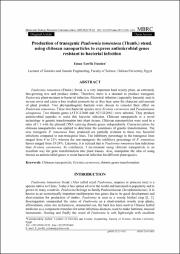Production of transgenic Paulownia tomentosa (Thunb.) steud. using chitosan nanoparticles to express antimicrobial genes resistant to bacterial infection
(ندگان)پدیدآور
Hussien, Emanنوع مدرک
TextOriginal article
زبان مدرک
Englishچکیده
Paulownia tomentosa (Thunb.) Steud. is a very important hard woody plant, an extremely fast-growing tree and produce timber. Therefore, there is a demand to produce transgenic Paulownia plant resistant to bacterial infection. Microbial infection (especially bacterial one) is serious sever and cause a loss in plant productivity as they bear upon the character and amount of plant product. Two phytopathogenic bacteria were chosen to consider their effect on Paulownia tomentosa. These two bacterial species were Erwinia carotovora and Pseudomonas aeruginosa. Two thionin genes (AT1G12660 and AT1G12663) were selected. They produce antimicrobial peptides to resist this bacterial infection. Chitosan nanoparticle is a novel technology in genetic transformation into plant tissues. Chitosan nanoparticles were used in a ratio of 1:1 with the plasmid DNA carrying thionin genes independently. Characterization for chitosan nanoparticles was applied to determine the conditions of genetic transformation. The new transgenic P. tomentosa lines produced are partially resistant to these two bacterial infections compared to non-transgenic lines. The inhibitory percentage in the transgenic lines ranged from 8 to 21% wherein the non-transgenic the inhibitory percentage of P. tomentosa leaves ranged from 53-24%. Likewise, it is noticed that is Paulownia tomentosa less infectious than Erwinia carotovora. In conclusion, I recommend using chitosan nanoparticle is an excellent way for gene transformation into plant tissues. Also, manipulate the idea of using thionin as antimicrobial genes to resist bacterial infection for different plant species.
کلید واژگان
Chitosan nanoparticleErwinia carotovora
thionin genes transformation
شماره نشریه
2تاریخ نشر
2020-06-011399-03-12
ناشر
Shiraz University Pressسازمان پدید آورنده
Lecturer of Genetics and Genetic Engineering, Faculty of Science, Helwan University, Egyptشاپا
2322-181X2345-2005





